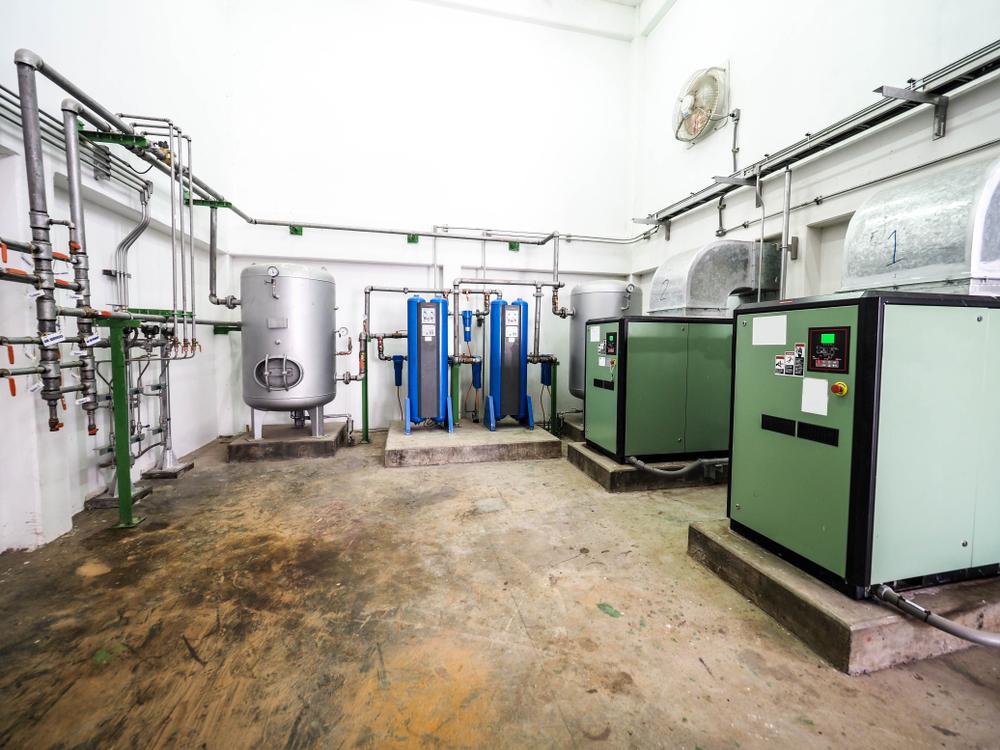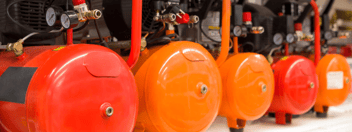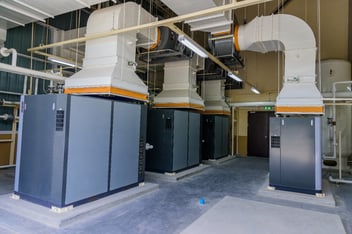Basic Air Compressor Terms and Definitions

Air compressors involve a lot of moving parts (literally). And, in addition to all the mechanical components, there are also numerous laws of physics to take into account. Given this complexity, even if you’re fairly familiar with air compressors, certain topics may still be unclear. So, to shed some light on air compressor fundamentals, we’ve compiled this list of common air compressor terms and definitions for you to reference.
Air Compressor Terms and Definitions
Absolute Pressure – The true pressure in relation to absolute zero. Typically calculated as gauge pressure plus atmospheric pressure (see ‘gauge pressure’ and ‘atmospheric pressure’).
Absolute Temperature – The temperature in relation to absolute zero rather than the freezing point. Calculated by adding 459.7 to Fahrenheit measurements and 273 to Celcius measurements.
Absorption – The event in which a desiccant absorbs moisture from the air and thus converts into a liquid (see ‘desiccant’).
Actual Capacity – The actual volume of air that is compressed and delivered to a discharge system when operating at rated conditions of speed, pressure, and temperature. Also referred to as Free Air Delivery (FAD).
ACFM – Stands for ‘Actual Cubic Feet per Minute’. A measure of the airflow rate at a defined point under specific conditions.
SCFM – Stands for ‘Standard Cubic Feet per Minute’. A measure of the airflow rate that is converted to standardized temperature, pressure, and humidity conditions.
Aftercooler – A heat exchanger device that reduces the temperature of discharged air. Enables the separation and removal of moisture from the air.
Air Compressor – A machine that utilizes a motor to compress air into a rigid tank, thus storing it as potential energy to be used in other mechanical processes.
Air Dryer – A drying mechanism that separates and removes condensate from the air, typically via cooling and/or absorption.
Air Receiver – A rigid tank in which pressurized air from an air compressor is stored. Receivers vary in size and large systems may utilize multiple units.
Atmospheric Pressure – The natural pressure exerted by the Earth’s atmosphere at a given altitude (14.7 PSI at sea level).
Brake Horsepower – The amount of power that needs to be applied to the compressor shaft to facilitate proper air compression and delivery.
Capacity – The volume of air that is delivered by an air compressor under certain conditions, typically measured in cubic feet per minute (CFM).
Centrifugal Compressor – A type of air compressor that uses an impeller to add kinetic energy to the air, thus increasing the pressure. Also known as an impeller compressor, radial compressor, or dynamic compressor.
Clearance – The volume of space between the cylinder head and the piston at the top of the upstroke. In other words, the total volume of the cylinder minus the displacement volume of the piston.
Compression – The phenomenon of increased pressure resulting from decreased volume.
Compression Efficiency – The proportion of actual compression power to theoretical compression power (due to the existence of limiting factors such as friction).
Compression Ratio – The proportion of inlet pressure to discharge pressure.
Cubic Feet Per Minute (CFM) – Metric used to measure airflow. Often expressed as either Actual CFM or Standard CFM (see ‘ACFM’ and ‘SCFM’).
Cycle / Cycle Time – The time it takes for an air compressor to go through the steps of loading and unloading compressed air. Longer cycle times equate to more efficiency.
Desiccant – A substance that attracts and retains water molecules, used as a drying agent to remove moisture from the air.
Discharge Pressure – The pressure at the output end (i.e. discharge flange) of an air compressor.
Discharge Temperature – The temperature at the output end (i.e. discharge flange) of an air compressor.
Filter – A device that acts as a sieve to remove particles from the air. Types include general purpose filters, activated carbon filters, water separator filters, and high-efficiency filters.
Flange Connection – A bolted connection point that joins the input or output end (i.e. inlet or discharge flange) to an external pipe.
Gauge Pressure – The pressure that most monitoring instruments will display. This excludes atmospheric (i.e. barometric) pressure. The two combine to form absolute pressure (see ‘absolute pressure’).
Horsepower – A unit of measurement to express power (550 foot-pounds/second or 745.7 watts).
Inlet Pressure – The pressure at the input end (i.e. inlet flange) of an air compressor.
Inlet Temperature – The temperature at the input end (i.e. inlet flange) of an air compressor.
Load Factor – The proportion of actual compressor output to maximum-rated output within a particular time frame.
Moisture Separator – A device that removes vapor and condensate from a compressed air system.
Oil-Free Compressor – A type of air compressor that does not require oil in the compression chamber. Advantages include superior air quality, reduced operating costs, and environmental considerations.
Pounds Per Square Inch (PSI) – A unit of measurement to express pressure. Equivalent to the force of one pound being exerted on one square inch.
Pressure Drop – A dissipation of pressure between a compressed air system and an adjoining component.
Preventative Maintenance – Routine, proactive maintenance procedures to ensure optimal air compressor performance, efficiency, and longevity.
Reciprocating Compressor – A type of air compressor that uses crankshaft-driven pistons to increase the pressure of the air within a compression cylinder. Also known as a piston compressor.
Refrigerated Air Dryer – A device that removes moisture from the air by cooling it, then draining the resulting condensate.
Rotary Screw Air Compressor – A type of air compressor that uses interlocking rotors to decrease the volume of the air as it moves through a compression chamber. Advantages include increased durability and efficiency.
Safety Valve – A device that allows air to be released from an air tank in order to prevent the internal pressure from exceeding a certain threshold.
Speed – A measure that indicates the RPM (revolutions per minute) of an air compressor’s rotor or drive shaft.
Vacuum Pump – A machine that, like an air compressor, uses pressure differentials to compel the movement of gas or liquid.
—
If you have any questions about air compressors, please don’t hesitate to give our team a call. Our experts will be happy to assist you. At TMI, we’re proud to provide 24/7 air compressor service and maintenance across West Michigan. We also provide rapid rental services to get you back up and running in the event of a breakdown. Contact TMI today to learn more.


